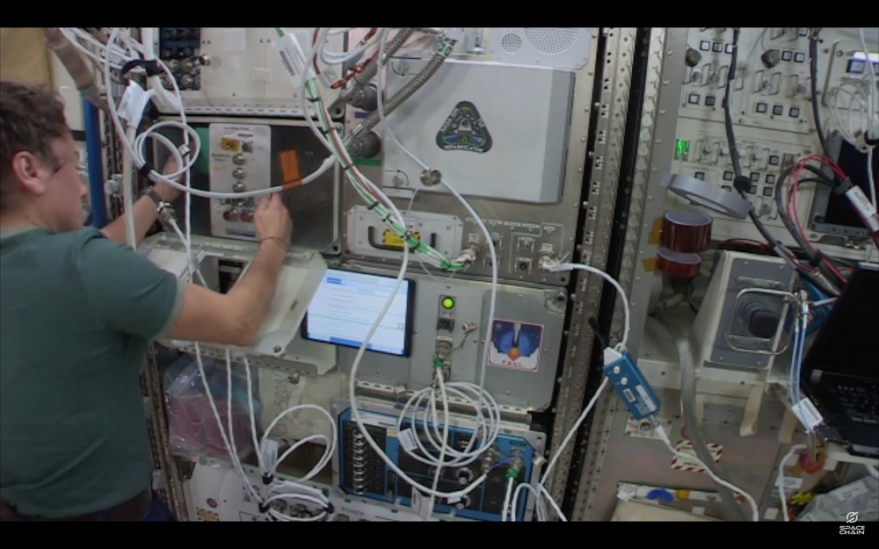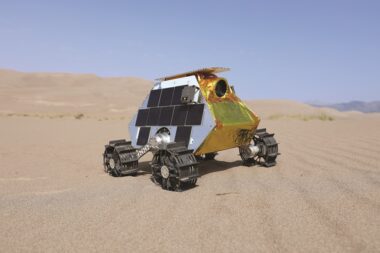Since it burst onto the scene with Bitcoin, blockchain has been linked with other cryptocurrencies, digital artwork and extraordinary energy consumption.
The heart of blockchain, though, is a distributed ledger with important applications for the space sector. Space companies, academic researchers and government agencies are exploring how distributed ledgers can make supply chains more efficient, enhance cybersecurity and simplify venture finance.
“Is there hype? Yes,” said Karen Jones, senior project leader and technology strategist at the Aerospace Corp. Center for Space Policy. “But underneath that is a structure that allows [distributed ledger technology] to play a role in various business processes that require transparency, accountability and decentralization.”
While many organizations see promise in blockchain, some of the more ambitious space-related applications are likely to evolve over the coming years.
Blockchain could provide tools, for example, to help an individual task a commercial satellite to collect imagery of a remote location, receive the imagery with confidence in the integrity of every pixel and transfer payment securely to the satellite operator.
With blockchain, organizations will be able to track transactions from a financial standpoint as well as from “an information assurance standpoint,” Steve “Bucky” Butow, Defense Innovation Unit space portfolio director, said in October at the 2021 Value of Space Summit. If a government agency orders commercial imagery, the agency will “want to know who has acted on that information since its origination,” he added.
Blockchain could even serve as the foundation for an international space traffic management system with organizations around the world supplying information on the location of orbital assets along with planned maneuvers.
“You have an immutable ledger that can’t be changed, and you know which transactions are recorded,” Jones said. “There is a degree of transparency for the parties involved.”
LEDGERS AND SUPPLY CHAINS
First a primer. Blockchain, also known as distributed ledger technology, is a digital database that records transactions between parties. Instead of relying on a central authority or intermediary to maintain the database, every transaction is encrypted and stored in blocks throughout the network. As a result, anyone with authority to access the ledger can view and verify transactions.

“Instead of trusted third parties like government agencies or financial institutions regulating whether or not something is true, blockchain can provide the source of truth,” said Hasshi Sudler, chairman and CEO of the Internet Think Tank, a cybersecurity consulting firm.
Because of its inherent transparency, blockchain offers a useful tool for tracing the international movement of goods. Everything from sustainable tuna to palm oil and exotic woods could be tracked from cradle to grave, said Spire Global CEO Peter Platzer.
Spire is supplying satellites and its Sabertooth supercomputer for a series of on-orbit blockchain demonstrations planned by SpaceChain, a startup based in Singapore.
The largest terrestrial blockchain networks require extensive computer processing and memory to record hundreds of thousands of daily transactions. Space-related blockchain networks are likely to be far less energy-intensive because most will be limited to a small number of trusted parties and therefore fewer transactions.
That’s the approach Burlington, Massachusetts startup 14bis Supply Tracking takes in its work with aviation and space companies. Currently, 14bis maintains a private distributed ledger for each customer that traces the chain of custody of specific parts in chronological order. Only vetted parties have access to the information, which is so indelible, it’s almost “chiseled in stone,” Eleanor Mitch, company CEO and co-founder, said at the Value of Space Summit. When necessary, 14bis can extend the network to other distributed ledgers if all parties agree and decide how much permission to give the newcomers, she added.
Through blockchain networks, organizations can share information on component inventories, shipments in transit and payments, without giving up trade secrets, said George Pullen, Columbia University adjunct professor and author of the book “Blockchain and the Space Economy.”
Distributed ledger technologies like blockchain also “build trust, reduce the risk of tampering and have the potential to reduce cost and ultimately shorten the time to market,” said Cloud Constellation CEO Cliff Beek.
Cloud Constellation is working with IBM, satellite manufacturer LeoStella and subsystem vendors to ensure that SpaceBelt, its cloud storage network planned for low Earth orbit, has the requisite global connectivity, data storage and edge computing to accommodate blockchain applications.
Similarly, LEOcloud, a startup that plans to co-locate edge computing services at ground stations before establishing a constellation of orbiting data centers, is designing data centers to support blockchain.
As a result, LEOcloud could assist “financial institutions wishing to provide digital currency-based services into regions of the world they otherwise cannot reach or don’t want to put the infrastructure investment in,” said LEOcloud CEO Dennis Gatens. “Blockchain gives them transaction security and immutability, whether it’s basic banking services or any financial tools or services they offer.”
SAFEGUARDING DATA
Cybersecurity is another key blockchain application.
Space companies and government agencies are exploring how blockchains could safeguard information in complex networks linking government and commercial satellites with space-based and terrestrial cloud infrastructure.
“There are many security issues that must be overcome to achieve this goal – access management, asset protection, and data trust and privacy,” Duncan Greatwood, CEO of Xage Security, a Silicon Valley cybersecurity startup, said by email.
Xage is developing a data-protection strategy for the U.S. Space Force that relies on blockchain technology to verify access to individual nodes in a network and to ensure data provided by the network is trustworthy.
The Air Force also awarded SpiderOak Mission Systems a Small Business Innovation Research contract to test its secure communications protocol, called OrbitSecure, on military satellites and ground stations.
At its foundation, OrbitSecure is zero-trust software. It starts with the assumption that no one should have access to data on the network and then establishes cryptographic keys that give various parties access to the datasets they need to perform their work.
A government agency, for example, could gather imagery from commercial Earth-observation satellites, transfer it through commercial communications satellites and process it in the cloud without worrying that any of the firms involved could modify the network architecture or manipulate the imagery.
“I can create a virtual hybrid constellation to serve my mission and then tear the keys down and break it apart when I’m done,” said Matthew Erickson, SpiderOak vice president solutions.

VENTURE FINANCE
While most space-related blockchains will limit access to trusted parties, venture finance may be an exception. Companies may opt for open ledgers to sell products, services or equity.
Lunar Outpost of Golden, Colorado, is preparing to send a small robotic rover to the lunar south pole next year on an Intuitive Machines lander. The primary payload for the mission is a Nokia LTE 4G payload to demonstrate high-bandwidth communications. While Lunar Outpost is selling much of the rover’s payload space through traditional contracts, some space will be sold through digital tokens on SpaceMart, an online platform being established by Copernic Space to convert assets like rides to orbit or shares in a space startup to digital tokens that can be bought and sold quickly and easily.
In addition to making space more accessible to the general public through its platform, Copernic Space wants to make space “more psychologically accessible,” said Grant Blaisdell, co-founder and CEO of the Los Angeles startup. “Space is intimidating. People think it’s only for billionaires and NASA. I want people to see that there are huge amounts of value and accessibility in the space market.”
This article originally appeared in the November 2021 issue of SpaceNews magazine.
